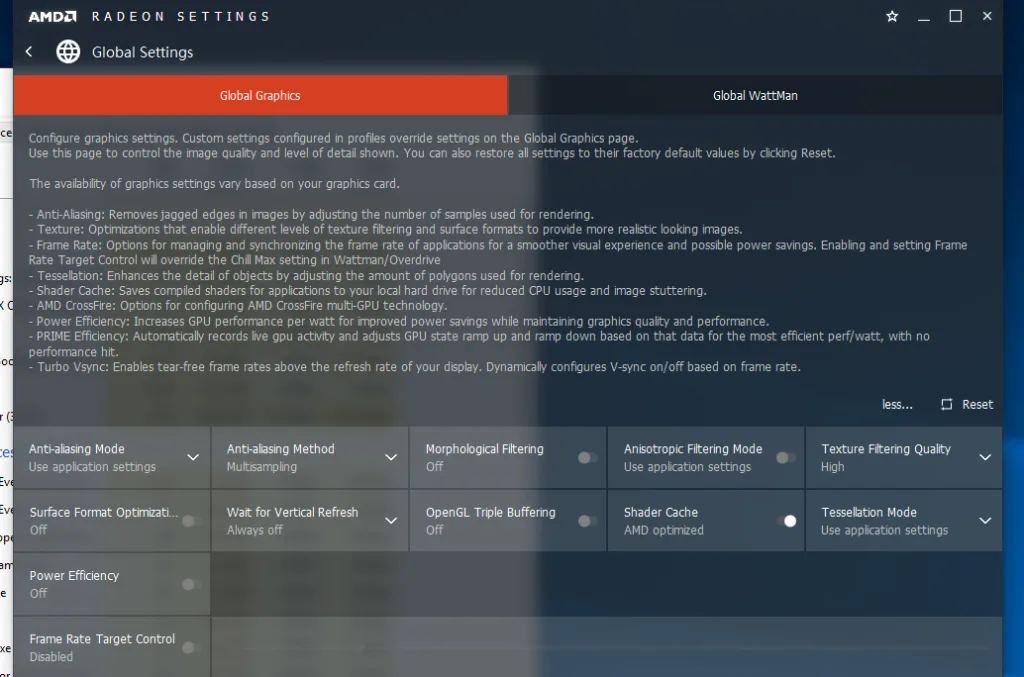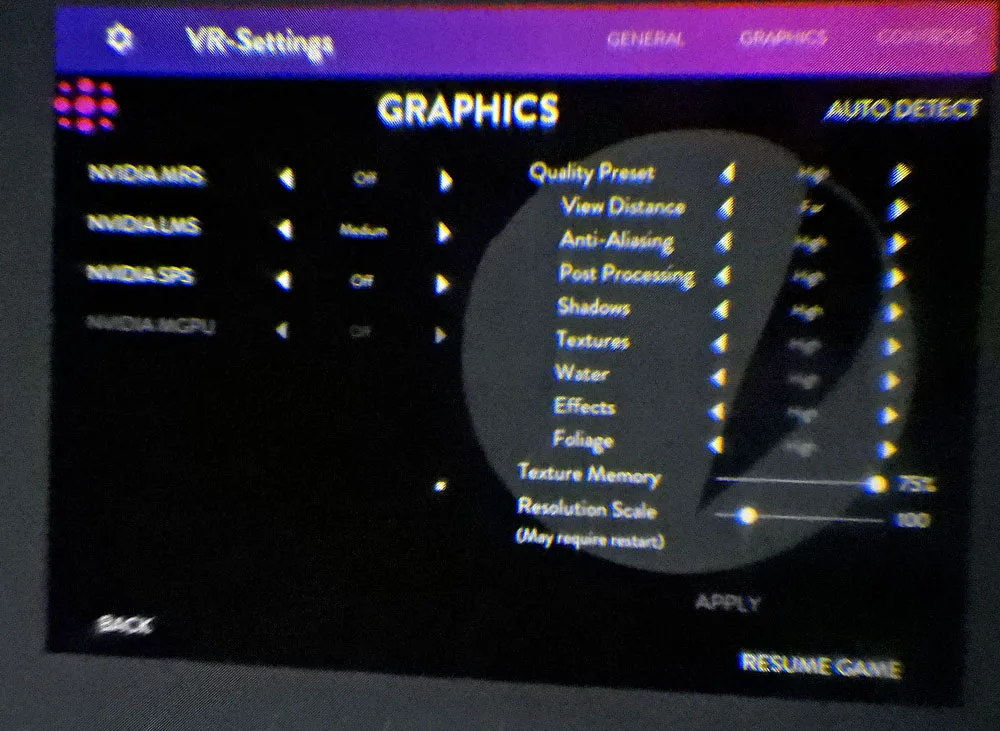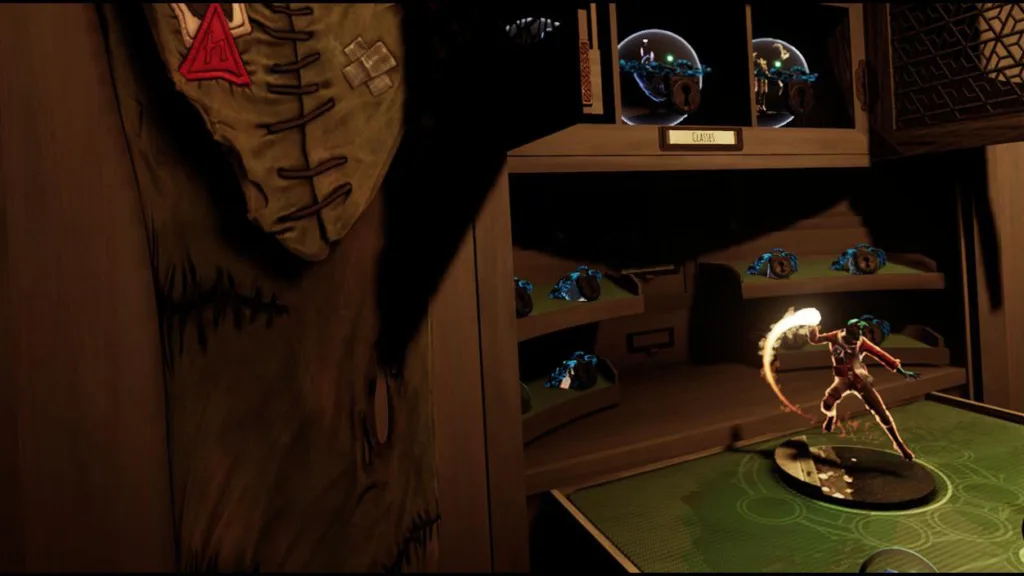We have been playing more than 30 VR Oculus Rift games using 4 top NVIDIA and 2 top AMD video cards, and we have just completed performance benchmarking for Robinson: The Journey, The Unspoken, and Obduction. Since we posted our original evaluation in January, we have benchmarked 6 VR games in our follow-up using FCAT VR.
Since PC benchmarking methods such as using Fraps do not accurately convey the performance that the user actually experiences in the HMD (Head Mounted Display, NVIDIA has released FCAT VR. We favorably compared FCAT VR with our own video benchmarks which use a camera to capture images directly from a Rift HMD lens.
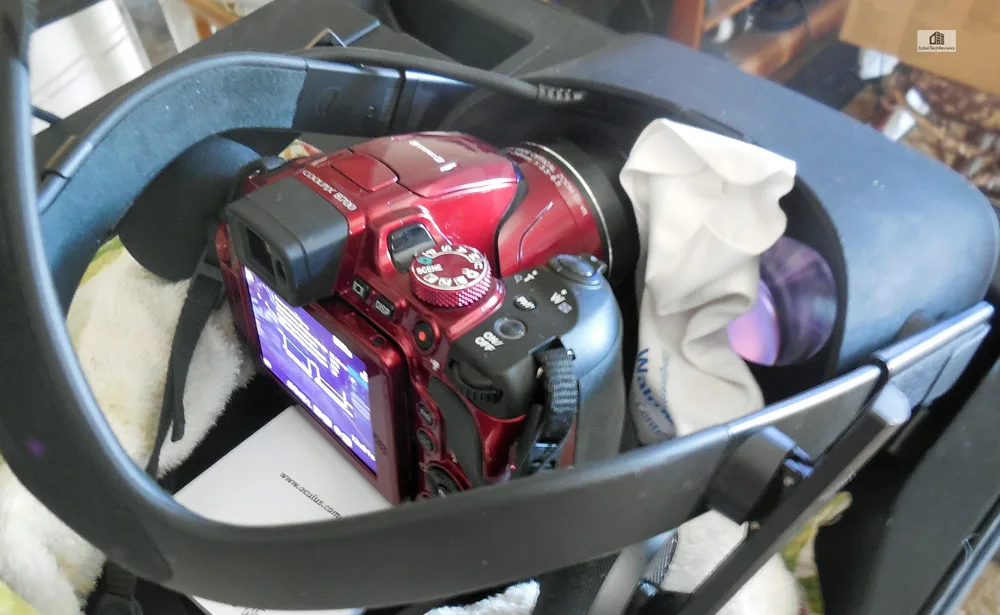
For each of our 6 test video cards, we will use Obduction to compare NVIDIA’s FCAT-generated frametime graphs and performance results directly with the Oculus Performance DeBug tool overlay running in real time in our videos. We will also benchmark Robinson: The Journey and The Unspoken using the GTX 1080 Ti FE, the GTX 1080 FE, the GTX 1070 FE, a EVGA GTX 1060 SC, the Fury X, and a Gigabyte G1-RX 480 at RX 580 clocks with our Core i7-6700K at 4.0GHz where all 4 cores turbo to 4.6GHz, an ASRock Z7170 motherboard and 16GB of Kingston HyperX DDR4 at 3333MHz.

Until FCAT VR was released in March, there was no universally acknowledged way to accurately benchmark the Oculus Rift as there are no SDK logging tools available. To compound the difficulties of benchmarking the Rift, there are additional complexities because of the way it uses a type of frame reprojection called asynchronous space warp (ASW) to keep framerates steady at either 90 FPS or at 45 FPS. It is important to be aware of VR performance since poorly delivered frames will actually make a VR experience quite unpleasant and the user can even become VR sick.
It is really important to understand how NVIDIA’s VRWorks and AMD’s LiquidVR each work to deliver a premium VR experience, and it is also important to understand how we can accurately benchmark VR as explained here. And before we benchmark Robinson: The Journey, The Unspoken, and Obduction, let’s take a look at our Test Configuration on the next page.
Test Configuration – Hardware
- Intel Core i7-6700K (reference 4.0GHz, HyperThreading and Turbo boost is on to 4.6GHz; DX11 CPU graphics)
- ASRock Z170M OC Formula motherboard (Intel Z170 chipset, latest BIOS, PCIe 3.0/3.1 specification, CrossFire/SLI 8x+8x)
- HyperX 16GB DDR4 (2x8GB, dual channel at 3333MHz), supplied by Kingston
- Oculus Rift including Touch Controllers.
- GTX 1080 Ti, reference clocks, supplied by NVIDIA
- GTX 1080, 8GB, Founders Edition, reference clocks, supplied by NVIDIA
- GTX 1070, 8GB, Founders Edition, reference clocks, supplied by NVIDIA
- EVGA GeForce GTX 1060 SC 6GB, at EVGA clocks, supplied by EVGA
- Fury X, 4GB, reference clocks
- MSI G1 Gaming RX 480, 8GB, at RX 580 reference clocks.
- Two 2TB Toshiba 7200 rpm HDDs for each platform
- EVGA 1000G 1000W power supply unit
- Corsair H60 Watercooler
- Onboard Realtek Audio
- Genius SP-D150 speakers, supplied by Genius
- Thermaltake Overseer RX-I full tower case, supplied by Thermaltake
- ASUS 12X Blu-ray writer
- Monoprice Crystal Pro 4K display
- ACER Predator X34, GSYNC display, supplied by NVIDIA/ACER
- Nikon B700 digital camera
Test Configuration – Software
- NVIDIA’s GeForce WHQL 382.53. High Quality, prefer maximum performance, single display.
- AMD Crimson Software ReLive 16.6.2 hotfix
- VSync/GSYNC are off in the control panel.
- FCAT VR benchmarking tools
- Oculus Rift Diagnostic tools
- Highest quality sound (stereo) used in all games.
- Windows 10 64-bit Home edition, all VR hardware was run under Oculus Rift software. Latest DirectX
- All applications are patched to their latest versions at time of publication.
- Sapphire TriXX was used for AMD cards.
- MSI’s Afterburner, latest beta, was used for NVIDIA cards.
VR Games & Apps
- Robinson: The Jouney
- The Unspoken
- Obduction
NVIDIA Control Panel settings
AMD ReLive Radeon Settings
Power Limit/Temperature targets are set to maximum by Afterburner.
Let’s individually look at the games that we benchmark starting with Obduction, Robinson: The Journey, and The Unspoken.
Obduction
Obduction is an adventure video game developed by Cyan Worlds that started with a successful Kickstarter campaign. Launching last year in late August, Obduction is considered the spiritual successor to Myst and Riven. A player finds himself in a strangely familiar alien world that he must explore to return home, and there is a big emphasis on puzzle solving which gets more difficult as the player progresses. The game was released for VR a couple of months later, and in March it received Touch support.
Obduction begins with the player being kidnapped and transported into an alien world. To return home, the player must solve increasingly difficult puzzles as he explores the 4 main areas of the game. There is no hand-holding in this game, and the puzzles may prove frustrating without a walkthrough guide as it may take anywhere from 5 to 15 hours to complete. The maps are large and the world is beautifully rendered with a mash-up of the familiar and an encroaching alien environment.
The game may be played seated or standing and the comfort level is reasonable as locomotion is provided by either teleportation or by a smooth forward movement with snap turn options. Unfortunately, there are still issues with the way that Touch is implemented and it is often difficult to interact with objects which definitely can break immersion. It is also possible to play with a gamepad.

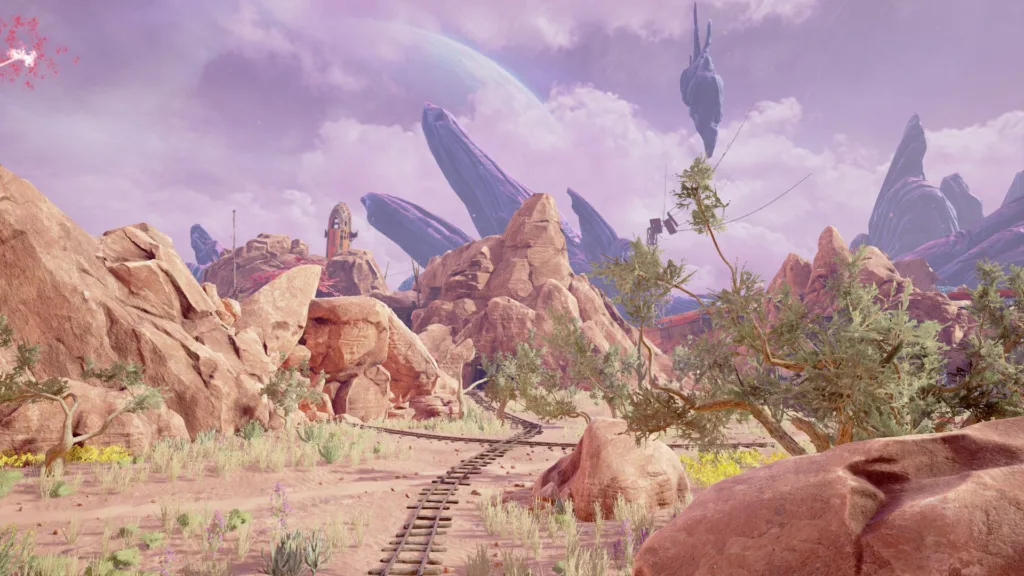
Let’s start with FCAT VR frametimes of Obduction running at Epic settings with the only two cards in our test bench that can manage them – the GTX 1080 Ti and the GTX 1080: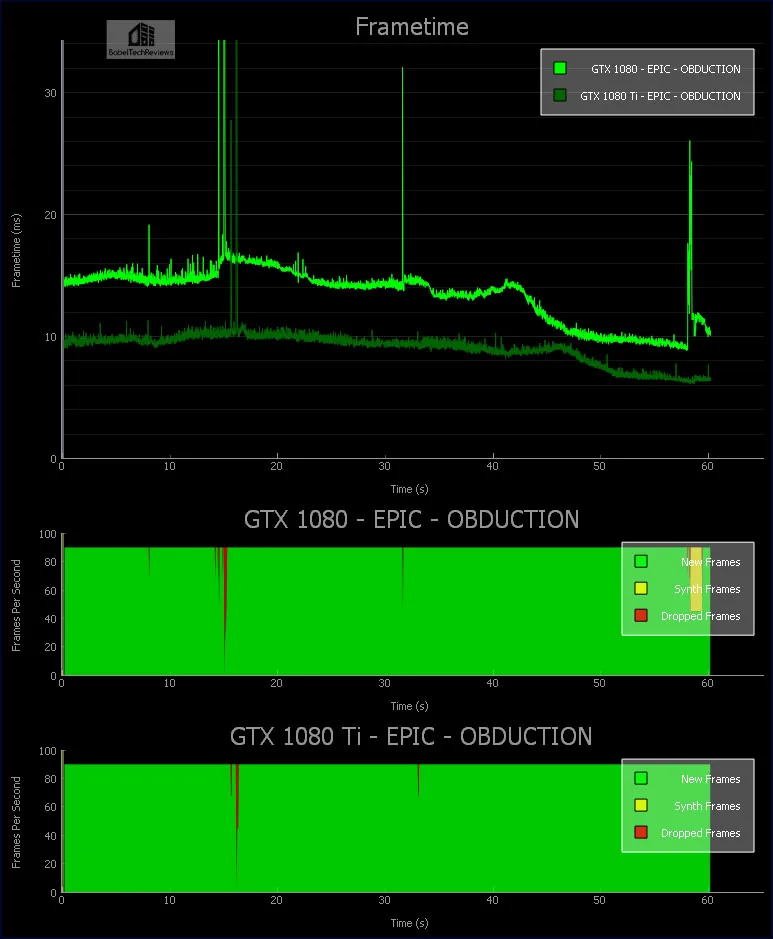
A GTX 1080 Ti is generally sufficient on Epic to deliver 90 FPS, but there are occasional sudden dips and stutters with dropped frames, while the GTX 1080 is generally considered insufficient on Epic, it still manages to deliver a similar experience to the GTX 1080 Ti – dropping frames also, but rarely going into reprojection.
Now let’s compare the FCAT frametime chart of all six of our cards running Obduction on High settings. Although there is a noticeable drop in visual quality going from Epic to High, the VR experience is still quite impressive.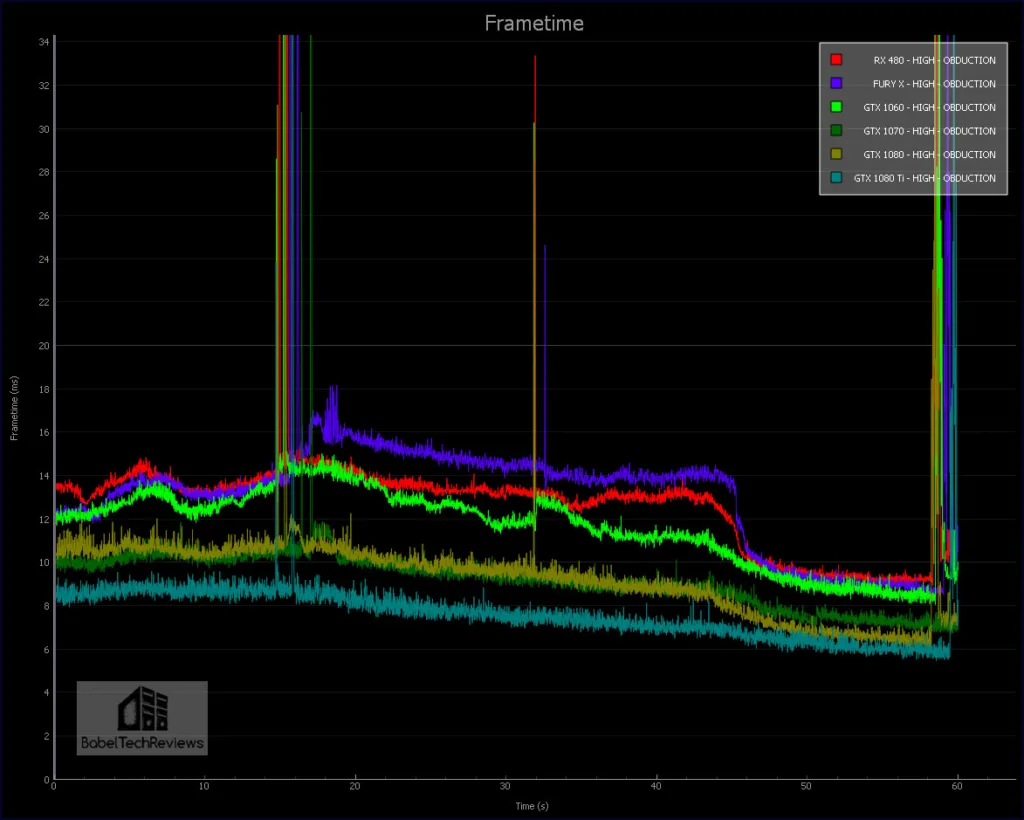
We see the similarly dropped frames with our GTX 1080 Ti and GTX 1080 on High as we do on Epic when we show the same graph with the intervals plotted: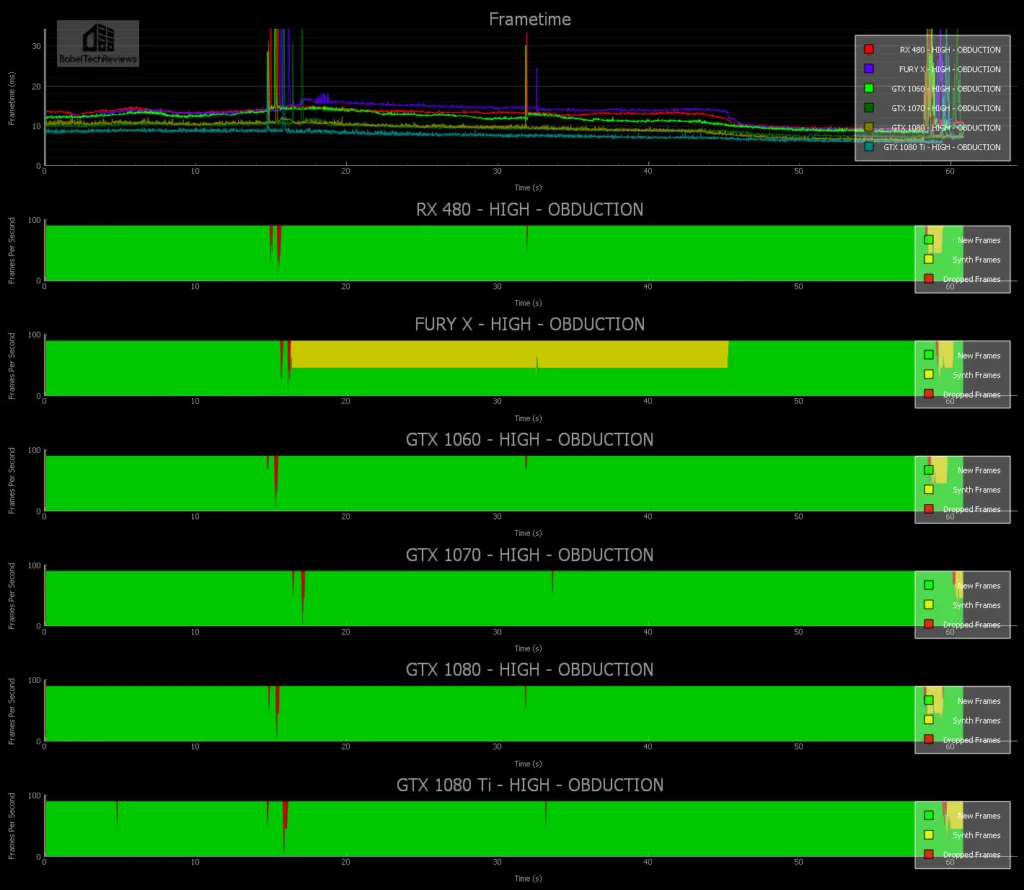
Here is the video of all 6 of our cards running on High. Make sure to watch the performance headroom and the latency figures and charts.
As you can see the cards deliver similar performance but the weaker cards are much more severely severely penalized when they get to the demanding areas.
Our Unconstrained FPS chart provides a bigger picture of what is happening in Obduction. Unconstrained FPS are data produced by the FCAT VR which is the 1000/average frametime that makes supporting evidence for the graphs that were presented above. In the graphs, it is important to realize that lower (latency) is better, while for unconstrained FPS, higher is better. Unconstrained FPS is based on the average frametime of each frame for the duration of the benchmark. Some frames may render quickly, others very slow. The very slow ones may throw off the average.
The GTX 1080 Ti should be able to provide an excellent experience with about 15% or more headroom on Epic settings, yet it still drops frames. The same thing happens to the lesser cards, and even on minimum settings, frames will still be dropped by any card that we tested. 
The Fury X really struggles with Obduction on High settings and our overclocked RX 480 at RX 580 clocks provides a better VR experience. We would suggest playing Obduction on Epic setting with a GTX 1080 Ti and maybe with a GTX 1080. Certainly the GTX 1080 and 1070 can provide reasonably smooth framerates on High. On the other hand a GTX 1060 and RX 480 can manage a mix of High and Medium settings, while Fury X settings need to be dialed down a bit more.
Overall, we would highly recommend Obduction to those who love adventure/puzzle games with the caveat that the adventure is marred somewhat by poor implementation of Touch control and by somewhat unoptimized graphics. If you love Myst and Riven, this game would be a “9”. If you don’t like puzzle games, then you will probably not like Obduction as it can become very frustrating.
Let’s check out a CryTek game next, Robinson: The Journey.
Robinson: The Journey
 Robinson: The Journey is first person adventure/puzzle game developed by Crytek using the CryEngine. Just like with Crytek PC games, the visuals are among the very best to be found in any VR game. For us, Crytek’s Robinson: The Journey was a blast to play in VR with a start to finish in about 6 hours in 2 settings. It’s probably Crytek’s best story of any game they made, so far. You even get a very cure baby T-Rex as a pet who likes to play hide and seek, roars on command to frighten and help move huge vegetation-eating dinosaurs, and is also essential to fetching an important part of a puzzle near the end.
Robinson: The Journey is first person adventure/puzzle game developed by Crytek using the CryEngine. Just like with Crytek PC games, the visuals are among the very best to be found in any VR game. For us, Crytek’s Robinson: The Journey was a blast to play in VR with a start to finish in about 6 hours in 2 settings. It’s probably Crytek’s best story of any game they made, so far. You even get a very cure baby T-Rex as a pet who likes to play hide and seek, roars on command to frighten and help move huge vegetation-eating dinosaurs, and is also essential to fetching an important part of a puzzle near the end.
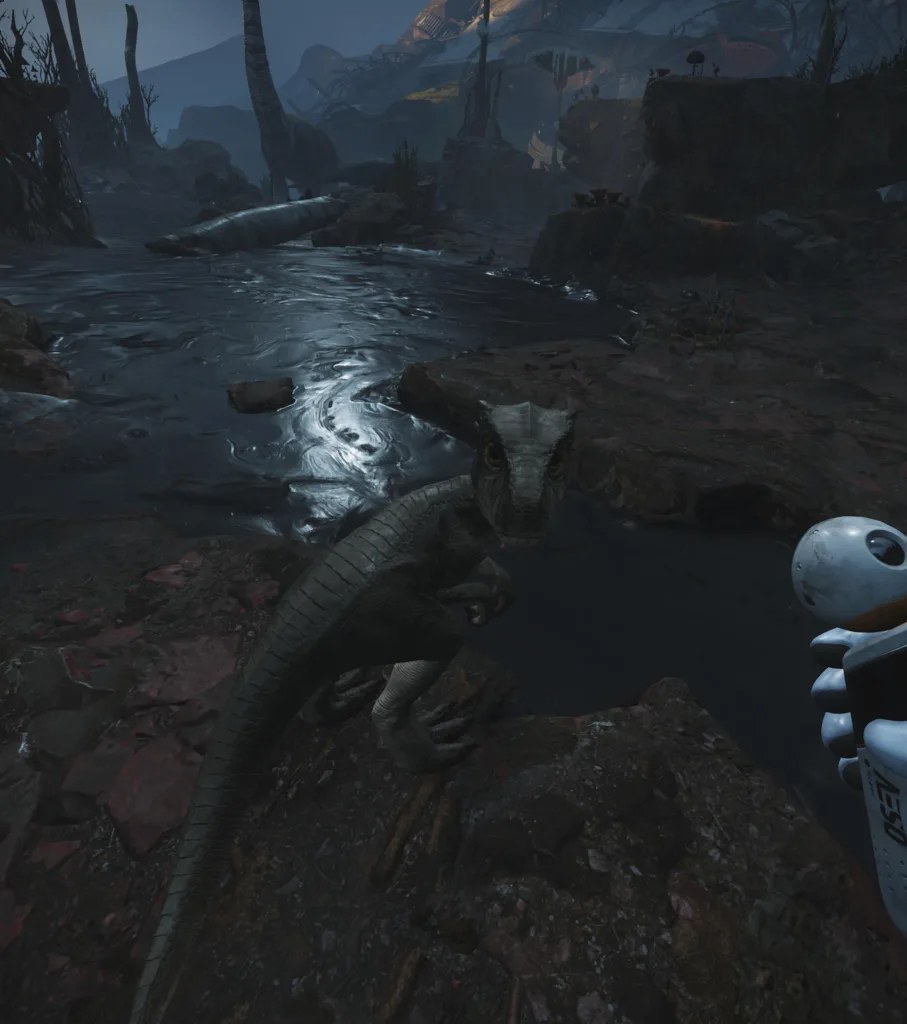
The visuals for Robinson: The Journey are utterly stunning and they add greatly to the immersion of the game. It’s the one game that I suffered with reprojection for a time just to enjoy the increased visuals with a 2.0 Pixel Density. There is incredible attention to detail as dense jungles with ancient trees are filled with wildlife, some of which are quite dangerous. There are several very different environments to traverse including the wreck of your gigantic spaceship and all of them are well done.
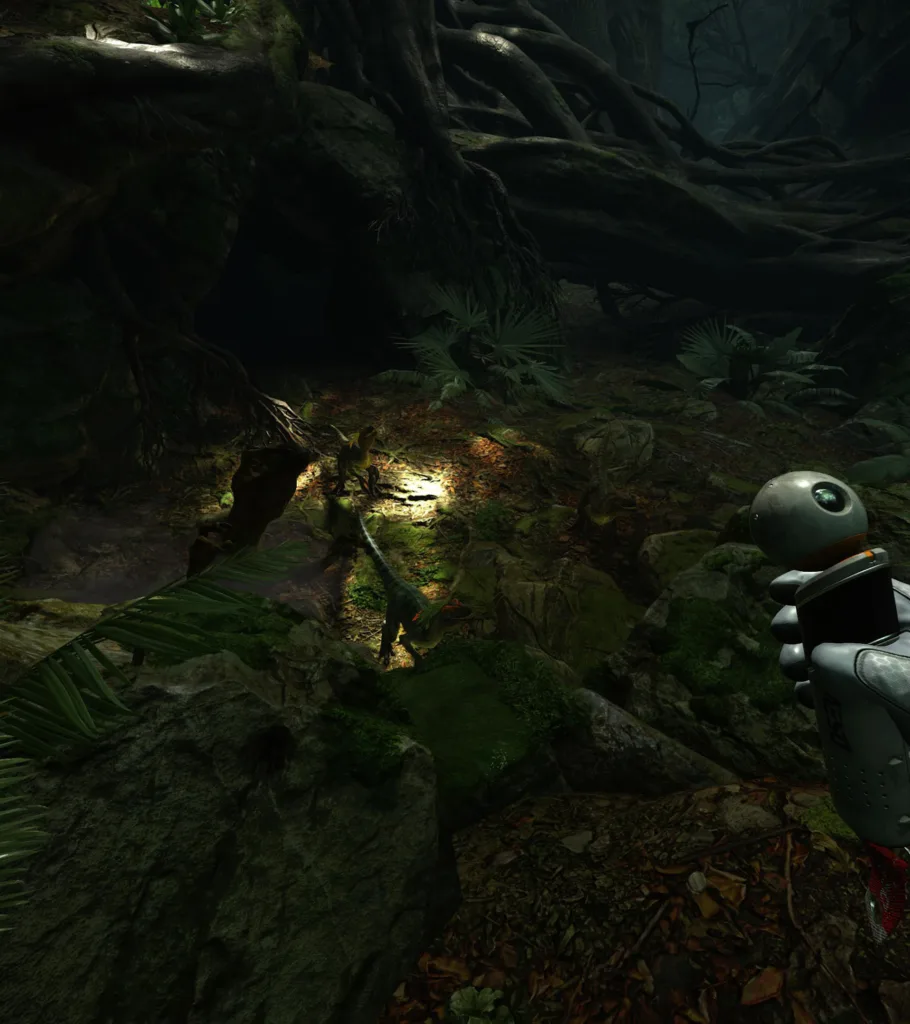
Robin has only one slow plodding speed as there is no running and the game will even slow down when you stare at either the sky or the ground as a safety net to keep the player from becoming VR sick. Climbing is emphasized and the mechanism is similar to Crytek’s other VR game, The Climb. 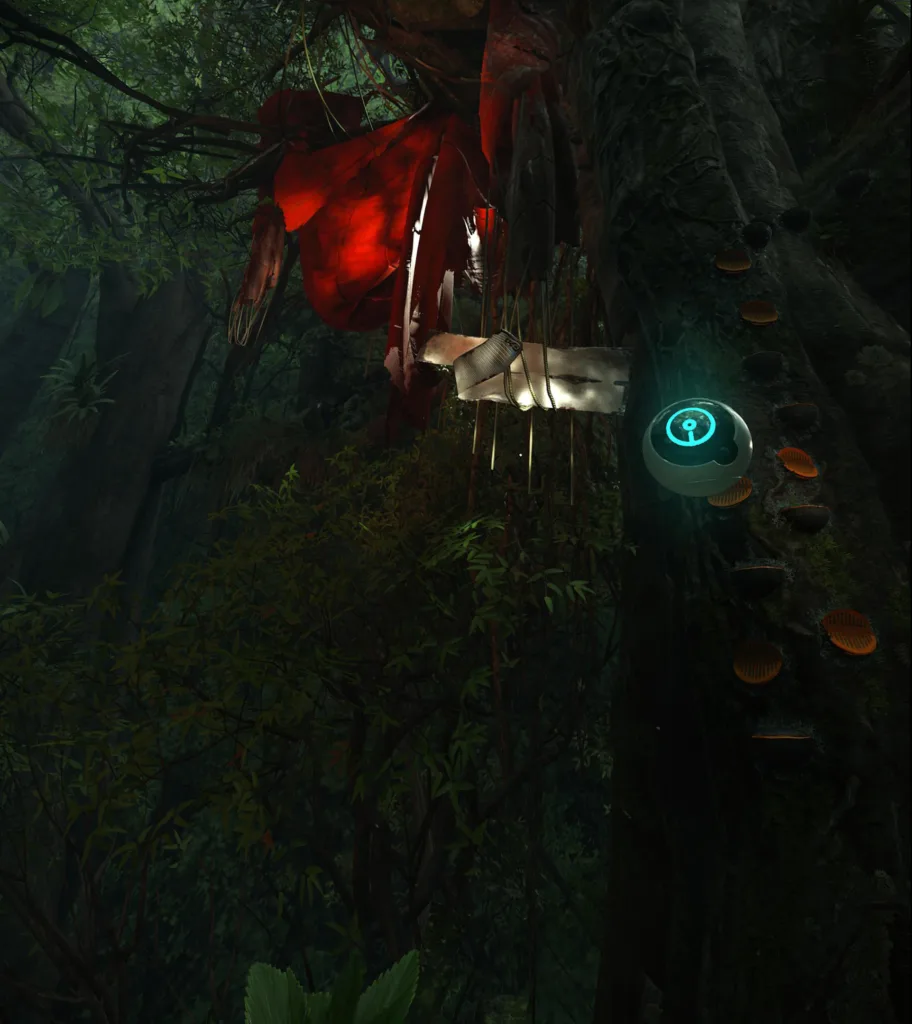 Before you can climb these giant trees, you must first solve the puzzle of the opening and closing of the climbing pads, and your timing is crucial or will drop to your death having to start over from the last checkpoint. And even high up in the trees, you will come across some truly massive beasts and you must figure out how to get them to move out of your way.
Before you can climb these giant trees, you must first solve the puzzle of the opening and closing of the climbing pads, and your timing is crucial or will drop to your death having to start over from the last checkpoint. And even high up in the trees, you will come across some truly massive beasts and you must figure out how to get them to move out of your way.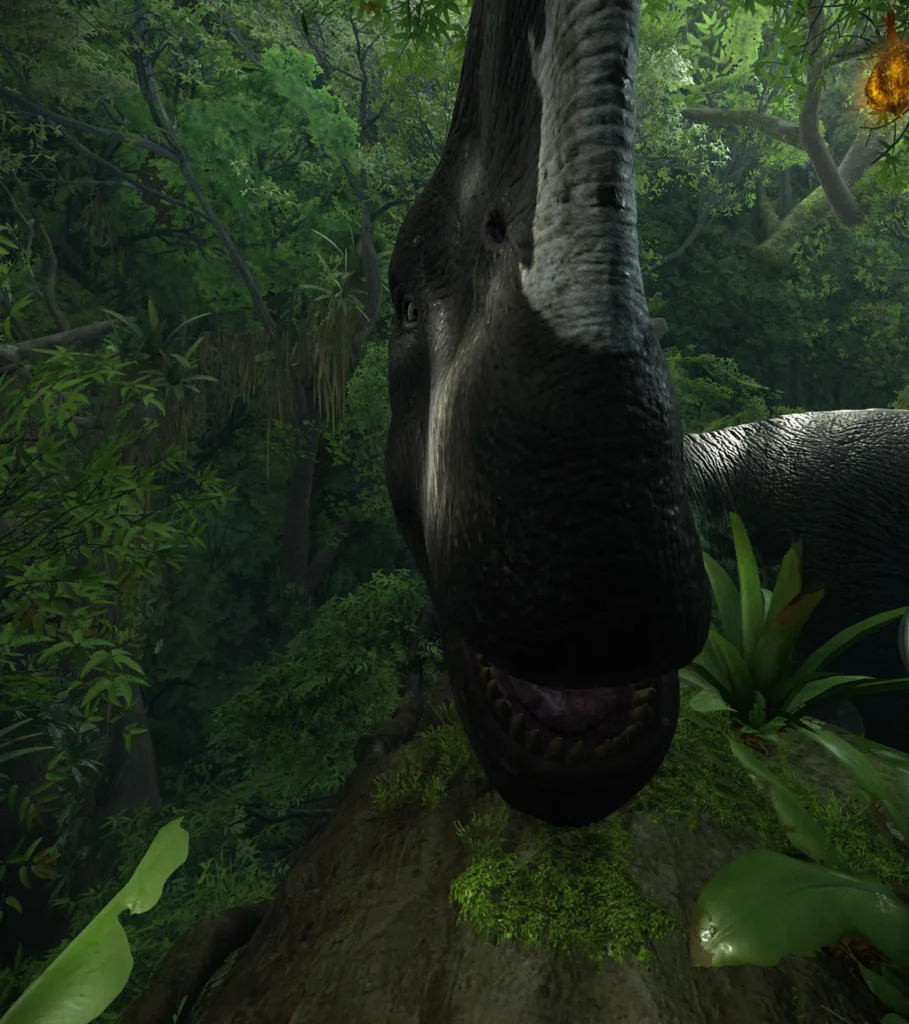
The overall experience in VR is amazing and Tyson III feels like a world that is occupied by a solitary human boy trying to make the best of a bad situation just like in the classic book, “Robinson Caruso” by Daniel Defoe. The levitating HIGS AI Orb acts as an adviser and protector for Robin, and is occasionally witty, but tends to become annoying after awhile. When HIGS gets annoying, it’s fun to chuck objects at it using Robin’s tool’s ability to levitate objects for a short distance and hear it say “ouch, ouch, ouch”.
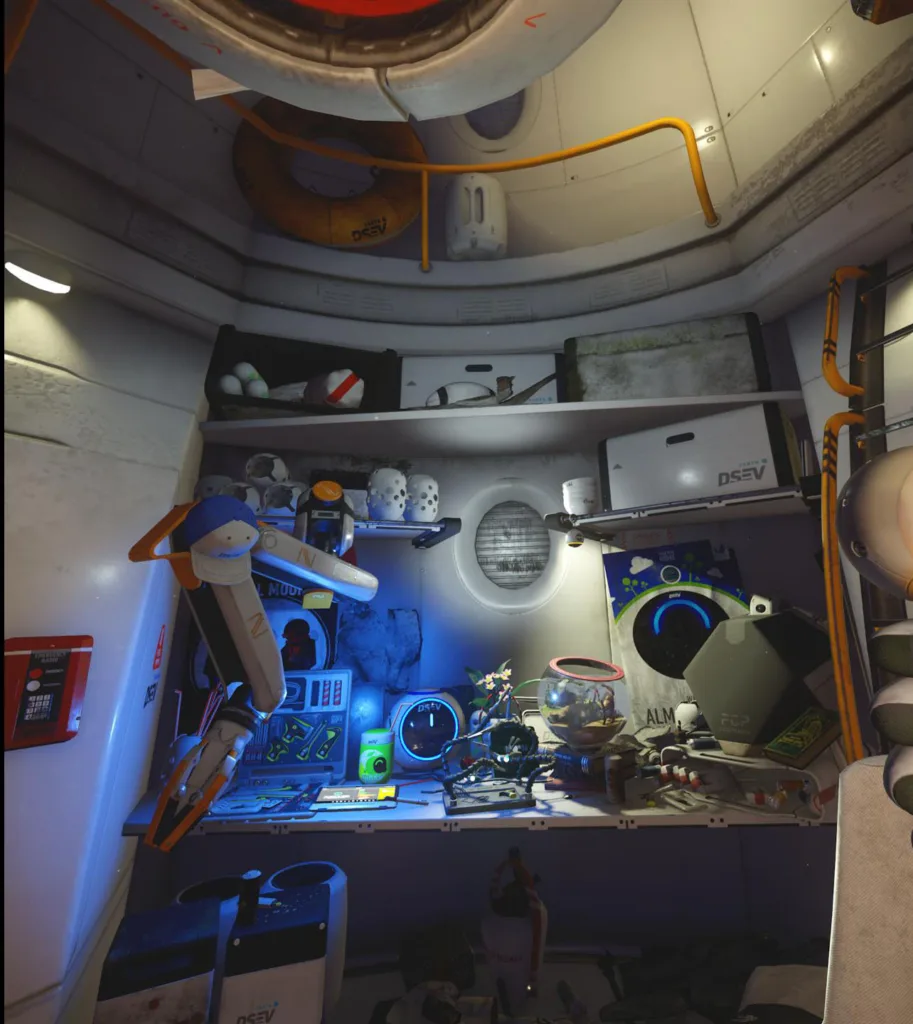
The game is linear and rather short if you are able to just rush through it, but there are optional quests to find memory cells of partially destroyed HIGS units and a sort of mini-game that catalogs the genetics of the vast array of animal life. The game would easily deserve a “9” except for the vagueness of the objectives and the fact that a player’s trial and error is “rewarded” by sending you back to the last checkpoint when you fail. It’s a 7.5 in our opinion overall as we are also stuck with using the gamepad instead of the Touch controllers.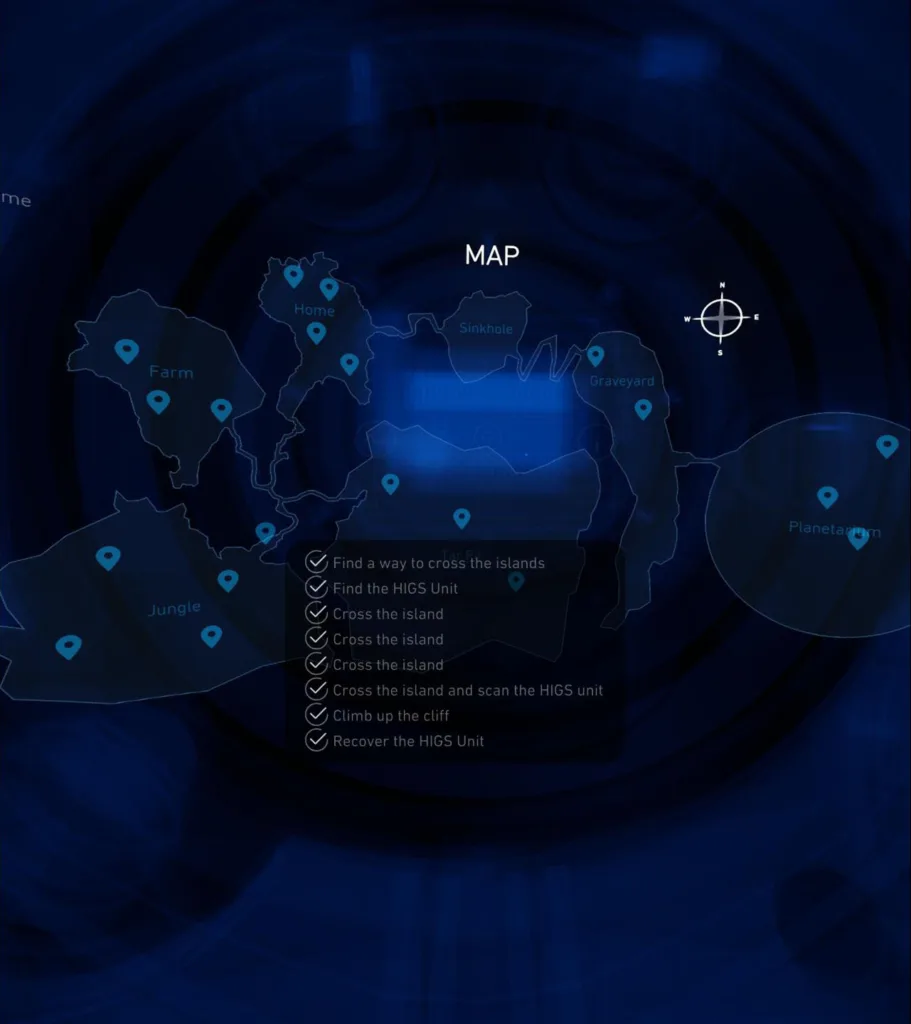
Locomotion is good and the comfort level was moderate for us. We highly recommend this game and are hoping for a sequel. Now let’s look at performance. We benchmarked the highest settings as below (but choose 1.0X for the resolution setting).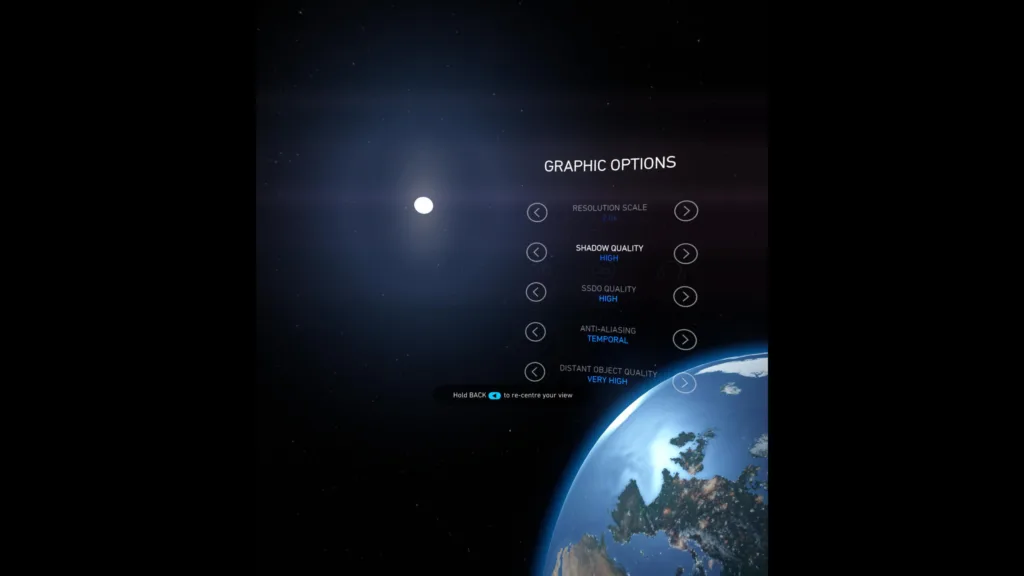
Here are the frametimes of all 6 video cards: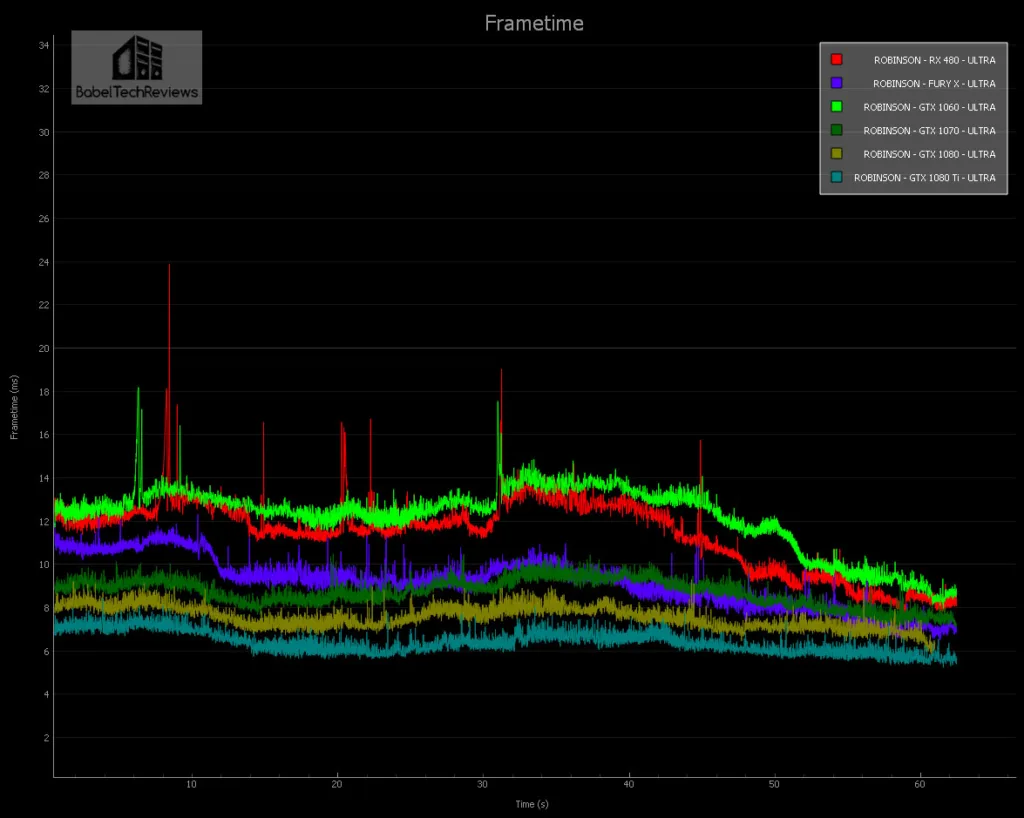
Here are the frametimes with the intervals: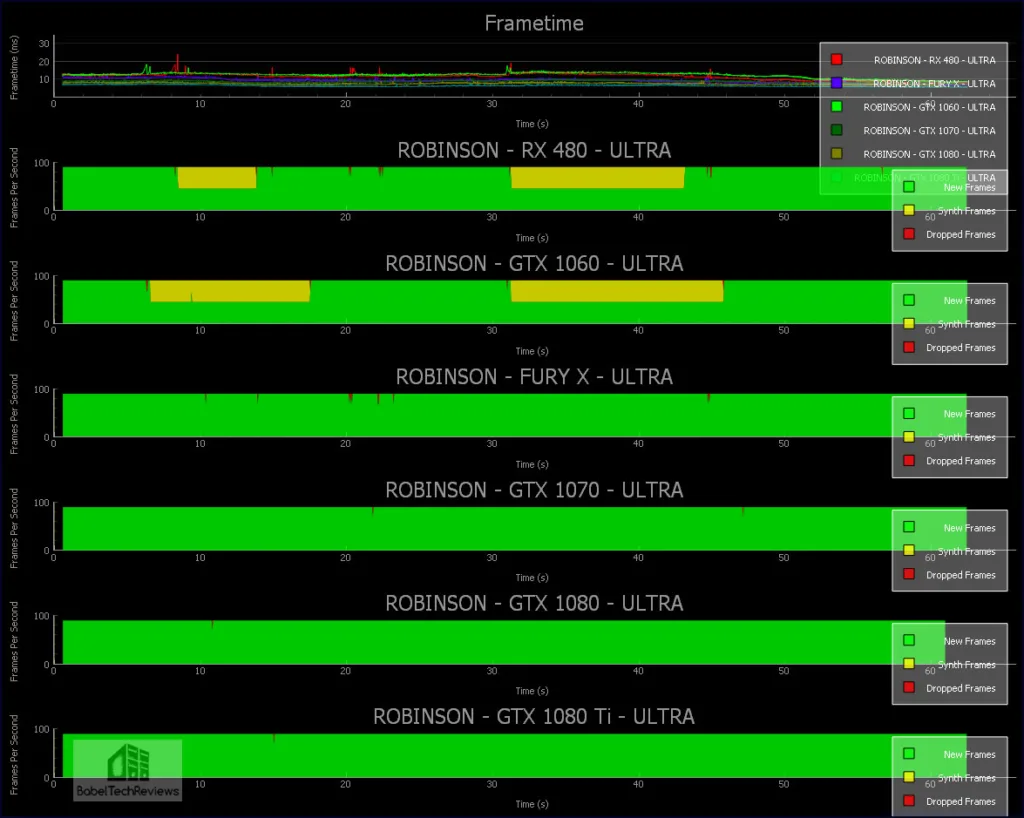
Now let’s look at the unconstrained FPS:
The GTX 1080 Ti and the GTX 1080 can easily increase the resolution scale or the pixel density to add to the immersion by sharpening up the visuals and decreasing the screendoor effect. Both the GTX 1070 and the Fury X can run easily with the highest settings although there are some dropped frames. Both the GTX 1060 and the RX 480 probably need to drop settings although they actually deliver a satisfactory experience with some reprojection even on the highest settings.
Overall, Robinson: The Journey is a visually impressive game that appears well-optimized and it gives a satisfactory experience across our 6 cards.
The Unspoken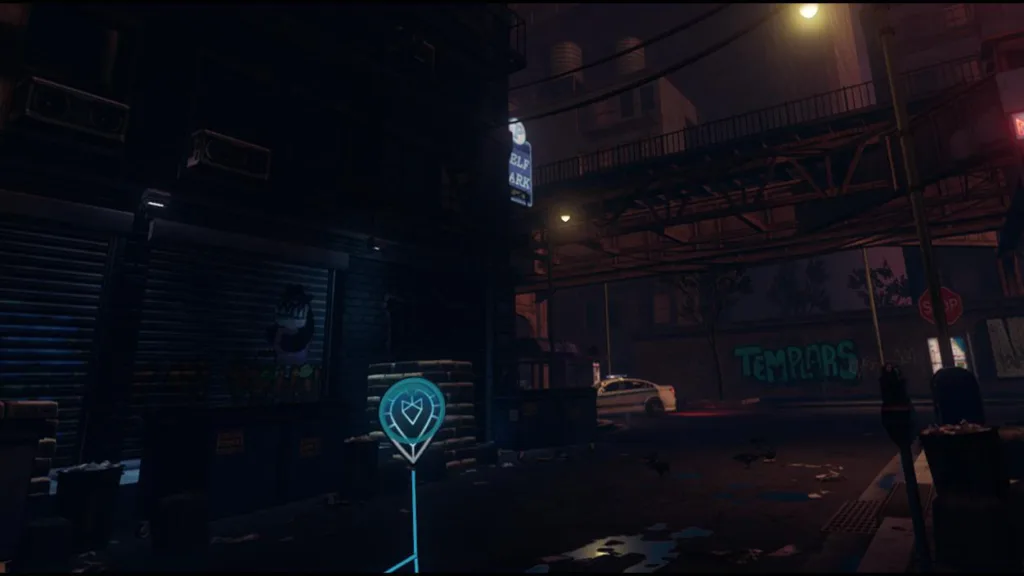
The Unspoken is basically a multiplayer urban fight club using magic set in an alternate reality Chicago. In fact, it is bound by arcane rules of secrecy so secret that even it’s name is unspoken. We first previewed it using the as then unreleased Touch controllers at NVIDIA’s GTX 1080 launch event in Austin in May, 2016. In fact, we were so impressed with the Touch controllers over using the Vive’s controllers, that we bought a Rift.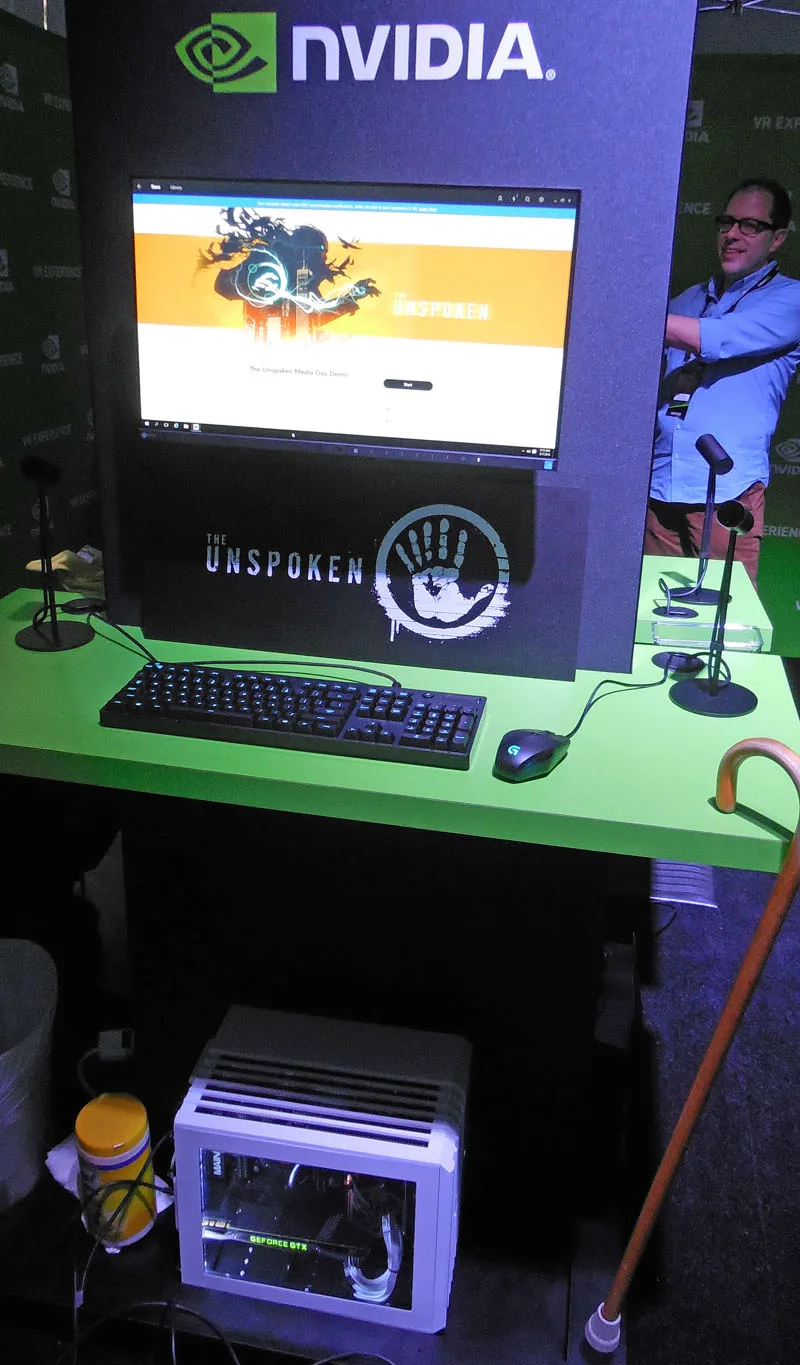
There is no single player mode although there is a backstory about the player being hunted for casting spells in public. The only thing you can really do by yourself is to practice against the A.I. as The Unspoken was built from the ground up as a multiplayer game. It features probably the most impressive use of the Touch controllers to date.
You must choose a wizard class and artifacts before you begin. Artifacts are powerful spells that can be used on occasion that require a more complex set of gestures than the usual attack or defense spell. The spells are simple and intuitive using the Touch controllers and the gesture motions are quite natural.
Performance
The Unspoken appears well-optimized and the only place you are likely to experience reprojection with a high performance video card is in your apartment which is the most demanding area of the game. We picked the highest settings for all of our cards.
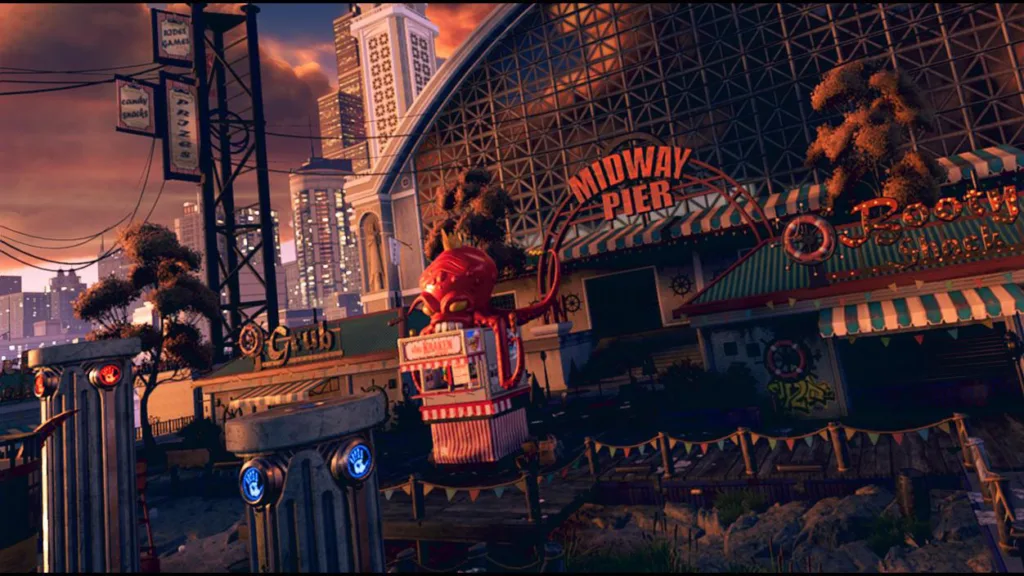 We performed our benchmark on the Midway Pier by casting one spell after another since playing a multiplayer match is anything but repeatable. We used the very highest settings and the first graph shows the frametimes of all 6 cards. The dips and rises in the charts tend to match up with the more demanding special effects of each (skull) spell being cast.
We performed our benchmark on the Midway Pier by casting one spell after another since playing a multiplayer match is anything but repeatable. We used the very highest settings and the first graph shows the frametimes of all 6 cards. The dips and rises in the charts tend to match up with the more demanding special effects of each (skull) spell being cast.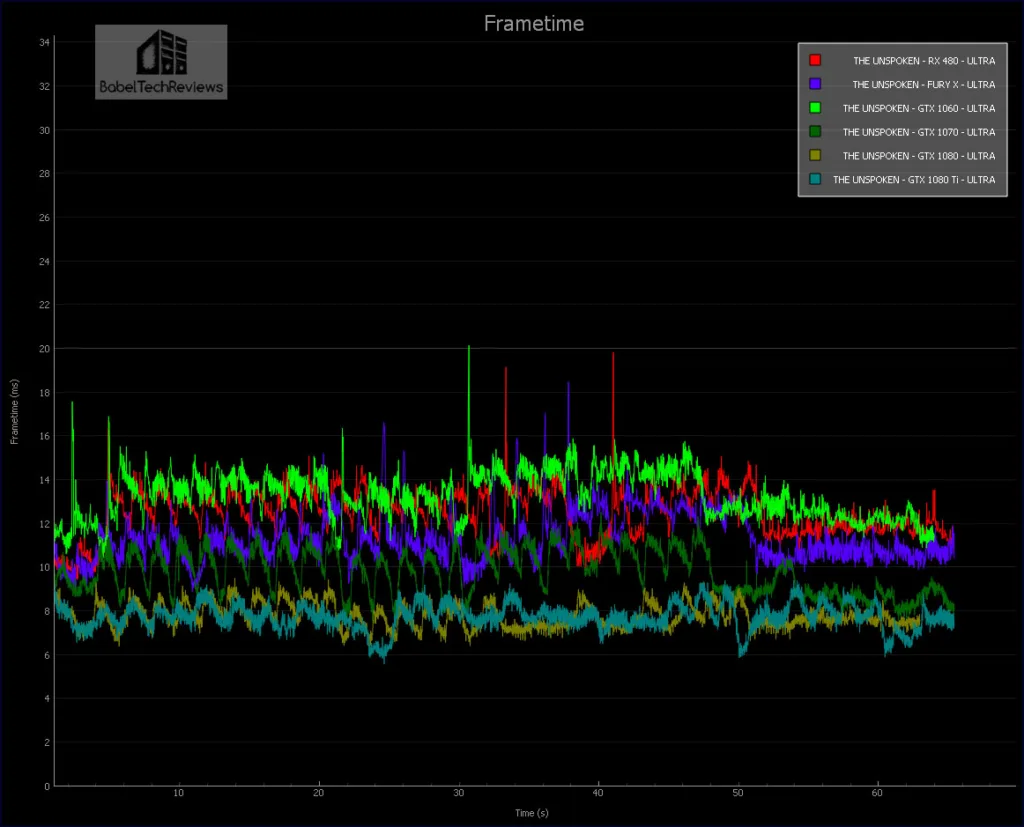
Now lets look at the frametimes with the intervals plotted.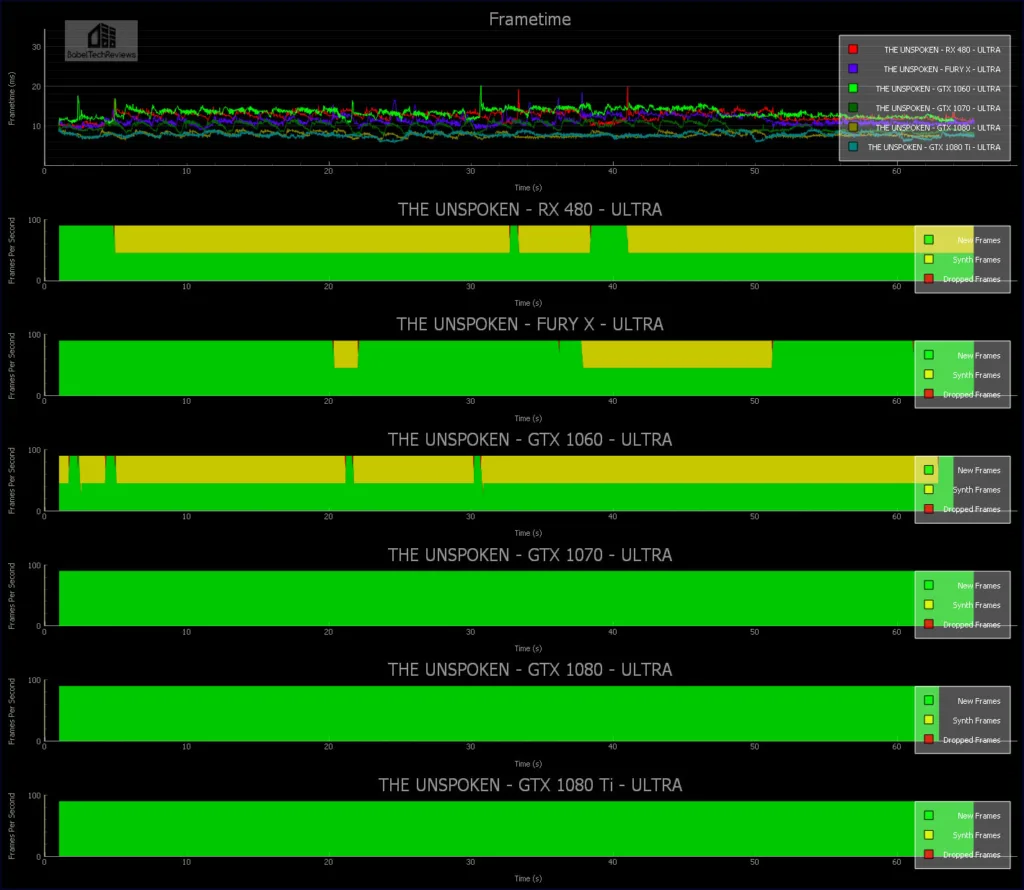
The final piece of the performance picture comes from looking at the unconstrained FPS.
As you can see both the GTX 1080 and the GTX 1080 Ti can easily run the game on maxed out settings and the GTX 1070 also can stay out of reprojection without dropping frames. However, the Fury X goes into reprojection for almost one-third of the run, and the GTX 1060 and the RX 480 mostly reproject frames with some dropped frames besides. We would recommend dropping settings for the RX 480 and for the GTX 1060.
Unconstrained Framerate Chart Leaderboard
Here is our leaderboard for unconstrained FPS of all of the VR game that we have benchmarked so far which allows us to see how quickly the system could have displayed the frames if not for the fixed 90 Hz refresh cadence.
These FPS or Framerates are averaged over multiple benchmark runs and may not match up with each graph exactly although they are close. But as you can see, the cards are ranked in terms of average performance using these six VR game benchmarks, from lowest to highest, from left to right. Clearly the GTX 1080 Ti is the fastest video card for VR, and together with the GTX 1080 they are able to provide a premium VR experience. The GTX 1070 also provides a very good VR experience and it is more consistent than the Fury X which may appear to be held back somewhat by its 4GB of vRAM. However, AMD has delivered on its promise for entry-level VR for the masses with the overclocked RX 480/RX 580 while the GTX 1060 is also a very good card for VR. We are looking forward to the release of RX Vega to see how it performs in PC and in VR titles.
Let’s head for our conclusion.
VR appears to be gaining some momentum, and as technological improvements bring smaller and lighter wireless HMDs along with with higher resolution and more powerful PCs to power them at a lower price, we will probably see mass acceptance in the next few years. At E3 we saw Doom VR and Fallout 4 being released for VR, and other AAA VR titles are on the way including a free Spider Man VR game released today. We feel that it is important to understand and compare performance of VR games across competing video cards so as to make informed choices. It is important to get a judder-free VR experience as your health is literally at stake!
BTR plans to stay at the forefront of this VR “revolution” and we have added VR benching to all of our video card reviews in addition to reviewing the latest PC games. We plan to review new VR games as they are released with the next performance review planned to be of Star Trek: Bridge Crew, Spider-Man Homecoming VR, and Battlezone. Plus we will update our 9-game VR benching suite just as we update our 25-game PC benching suite.
We are planning a new Ansel-themed Summer Contest at BTR which will feature a a 64-GB GTX USB flash drive as Grand Prize which is a collectable as only 1080 were made by NVIDIA. The runner up prize will feature a Level 30 loot box from Green Man Gaming which includes Mass Effect: Andromeda Origins. Stay tuned.
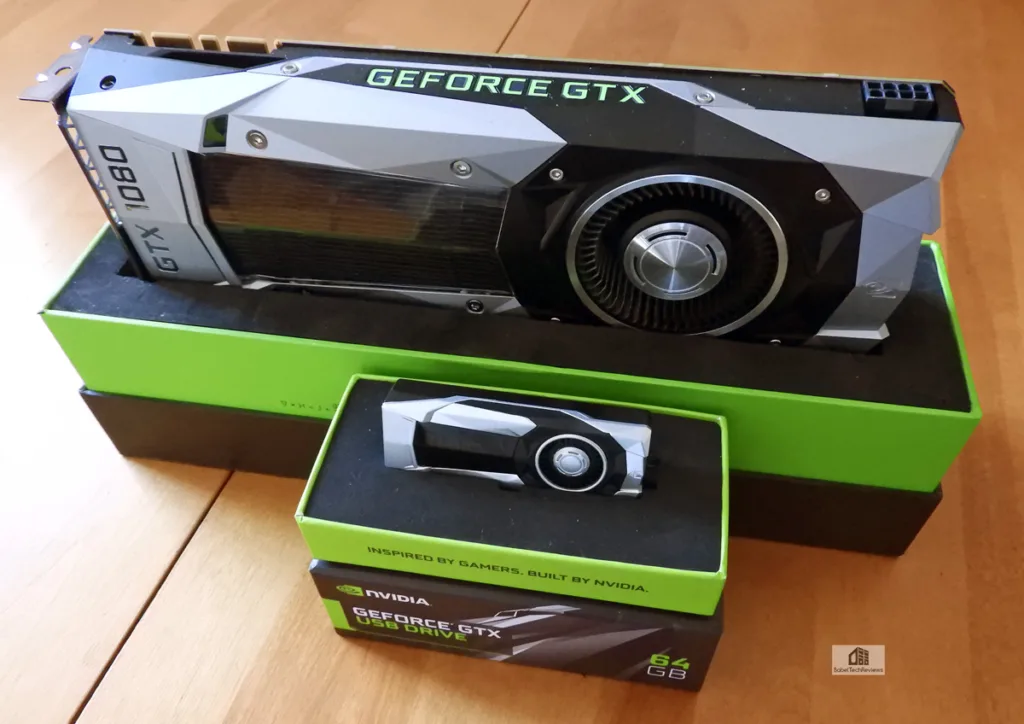
Happy Gaming!


